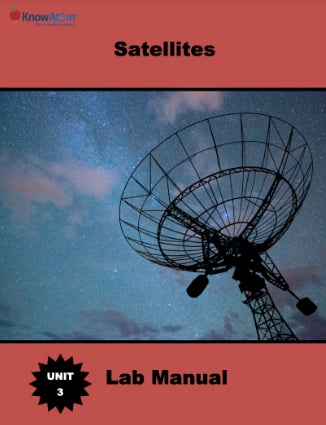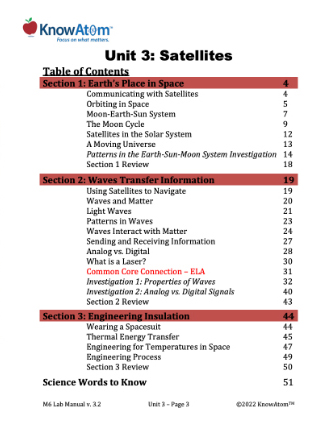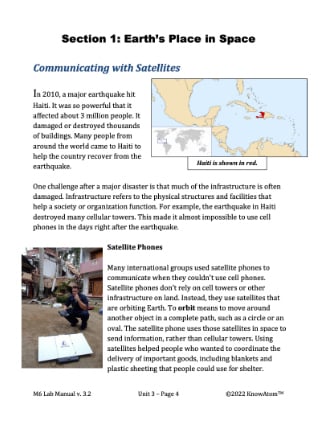Science background provides teachers with more in-depth information on the phenomena students explore in this unit. Below is an excerpt from this section on the Sun-Earth-Moon system.
Orbiting Earth
All satellites orbit Earth because of two interacting factors: gravity and inertia. Remember that gravity is the force of attraction between all matter, and that Earth is so massive that its gravitational field extends beyond the atmosphere, pulling on all objects within it.
The force of Earth’s gravity doesn’t pull the satellites down to Earth’s surface, however, because all objects in orbit are also moving sideways, at approximately 90 degrees to the force of gravity. For example, the moon moves at a speed of 3,683 kilometers per hour.
If Earth’s gravitational field didn’t exist, all satellites would travel in a straight line because of inertia. Inertia is the tendency of an object at rest to remain at rest and an object in motion to remain in motion unless acted on by an outside force. If a ball is at rest on the ground, it will not suddenly start moving on its own. It needs an outside force—such as you kicking it—to cause it to move. Similarly, once the ball starts moving, it would continue moving forever if no other forces acted on it. Here on Earth, both friction and air resistance eventually cause the ball to slow down by transferring energy out of it.
In space, there is no friction or air resistance. Instead, Earth’s gravity provides the outside force that changes the motion of the satellites. Earth’s gravitational field is so strong that its attractive force pulls on the satellites as they move. For an object to remain in orbit, its speed must be balanced by the pull of gravity. If its speed is too slow, it will fall back to Earth. Too fast, and it will fly off in a straight line in space.
Satellites orbit at different speeds and different distances from Earth. For example, some satellites are geostationary, traveling from west to east over the equator and moving in the same direction and at the same speed as Earth. As a result, it appears from Earth as though they don’t move because they are always above the same spot on Earth.
Systems in Space
Each of the satellites orbiting Earth forms a system made up of them and Earth. For example, the moon is a natural satellite that forms an Earth-moon system. It forms a system because it and Earth are connected, interacting parts that make up a more complex whole.
At the same time as the satellites orbit Earth, Earth itself is a satellite in motion, orbiting the sun. The sun is a star at the center of a solar system. A solar system is a collection of planets and other objects that orbit a sun. A planet is a body that orbits the sun, is massive enough for its own gravity to make it round, and has cleared out smaller objects around its orbit. There are currently eight known planets in our solar system: Mercury, Venus, Earth, Mars, Jupiter, Saturn, Uranus, and Neptune. As of 2016, a ninth planet has been identified far beyond Neptune, but it hasn’t yet been confirmed.
All of the planets orbit the sun for the same reason that satellites orbit Earth: gravity and inertia. The sun is so much more massive than any of the planets that its gravitational field pulls Earth and the other planets into orbit around it. The perpetual motion of the planets is due to inertia. Earth continues to spin and hurtle through space at an average speed of 30 km per second because there is nothing blocking its path.
The closer a planet is to the sun, the stronger the gravitational pull and the faster the planet moves around the sun. Planets that are farther from the sun have a slower orbit because the gravitational pull weakens. Planets closer to the sun also have less distance to travel to complete an orbit around the sun. For example, Neptune, the farthest planet from the sun, takes almost 165 Earth years to orbit the sun. Mercury, the closest to the sun, takes three Earth months.
The Sun’s Energy
In addition to anchoring all of the objects in the solar system, the sun plays another important role on Earth: it provides energy to the planet in the forms of light and heat. The sun is so powerful that it provides all of the light and heat needed for life on Earth. It does this through exothermic reactions that take place deep within the sun’s interior. Remember that exothermic reactions are chemical reactions in which energy is released into the environment. The light and heat produced by the sun are evidence of these exothermic reactions. The sun transfers energy to Earth through radiation—heat transfer that occurs without contact between the heat source and the object heated.
As the sun shines, it lights up Earth. However, Earth is also rotating (spinning) once every 23 hours and 56 minutes. As it rotates, the sun lights up half of the planet at a time. This is day and night on Earth. Different parts of the planet experience variations in the number of hours of daylight compared to night depending on the time of year, but the length of one complete day is always 24 hours.
The sun also lights up the moon. The moon doesn’t emit its own light. Instead, it reflects the sun’s light, which bounces off of the moon and then travels to Earth. The lit part of the moon that we see from Earth depends on the moon’s position in space relative to Earth and the sun. You may have heard of “the dark side of the moon.” This phrase came about because here on Earth, the same side of the moon is always facing Earth. However, it isn’t true that the side of the moon facing away from Earth is always dark. Just like on Earth, part of the moon gets light, and then dark.
The same side of the moon always faces Earth because it takes the moon the same amount of time to complete one rotation as it does to complete one orbit around Earth. The moon completes one rotation and one orbit around Earth in approximately 29 days. This also means that one day on the moon equals about 13 days on Earth. This is because Earth rotates much more quickly than the moon.








